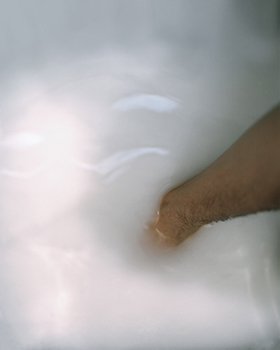April 15–May 21, 2016
Reception: April 15, 6–8pm
MFA Colloquium (artist gallery talks):
Monday, May 2, and Wednesday, May 4, 6:30pm
Visual Arts Center
Department of Art and Art History
Art Building
2301 San Jacinto Blvd.
Austin, Texas
The Department of Art and Art History at The University of Texas at Austin presents milkVOICE, an exhibition showcasing the work of ten studio artists completing their Master of Fine Arts degrees. The work will be on display at the Visual Arts Center (VAC) from April 15 to May 21. An opening reception honoring the artists will be held Friday, April 15, 6–8pm. The MFA Colloquium, a two-night series of artist gallery talks, will take place May 2 and 4 at 6:30pm.
The culmination of an intensive three-year program of work, milkVOICE features artworks made in a variety of media including sculpture, painting, print, photography, installation and video. These ten artists use their work to explore the world around them—to connect, describe, communicate and question. Their works explore a diversity of themes including embodiment, desire, relationships, personal connections to specific environments and transhuman possibilities of the future and near-now.
Adam Boley (Texas) records duck hunts in which he has participated. His videos of these events explore notions of tradition, masculinity, anticipation and duration as well as our relationship to animals and landscapes.
Roni Chelben’s (Israel) psychologically charged videos document her attempts to create relationships while simultaneously recording her failure to do so.
Adam Crosson (Arkansas) makes sculptures and photographs that reveal complex conditions of site, identity and place.
Annie May Johnston (Colorado) compresses layered and abstracted interiors through skewed perspective, pattern, collage and layering, resulting in a dream-like and optically vibrant environment.
Gracelee Lawrence’s (North Carolina) works consider the systems and structures of control around female bodies. She uses food as a reference to and replacement for the body in sculptures, fountains, videos and drawings.
Bryan Martello (Massachusetts) uses the camera as an elevating tool, transforming the overlooked and cheap into the desirable, thereby constructing a catalog of eccentrically touched images.
Elizabeth McClellan (California) creates a multi-media storytelling environment in which she explores social and physical porousness through accelerationist fantasies of genetic manipulation.
Annie B. Miller (California) paints liminal spaces of sensuality and desire, the longing to touch, to penetrate, to hold and make contact and the inherent failure or displacement of this longing.
Rachel Stuckey (Texas) uses video, computers and the Internet to think about technology’s influence on human bodies, minds and systems of belief.
Anne Clare Rogers’ (Minnesota) minimal sculptures are odd approximations of human bodies. They locate themselves somewhere between the wish and the fact.
About the MFA Studio Art program
Over their course of study, MFA students in Studio Art work closely with department faculty to fine-tune existing skill sets and develop new approaches, both conceptual and technical, to their studio practice. In a challenging interdisciplinary environment, students often work across media and in close collaboration with one another, exploring the potential overlaps and depths of established disciplines. The department’s visiting artist and critic program brings acclaimed professionals from outside the university into graduate studios. As part of the diverse intellectual community that makes up The University of Texas at Austin, students have access to resources across campus allowing for a richly informed approach to art making.
About the Department of Art and Art History
The Department of Art and Art History at The University of Texas at Austin is one of the largest and most diverse in the country. It includes the divisions of Art Education, Art History, Design, and Studio Art and reflects the rigorous standards of a flagship institution, while offering an intimate environment for students to train as scholars, practitioners, and educators in the arts. The department’s 22 full-time Studio Art faculty work closely with the program’s 28 graduate art students. The faculty proudly celebrates these 10 artists whose culminating exhibition, milkVOICE, completes their graduate education.

